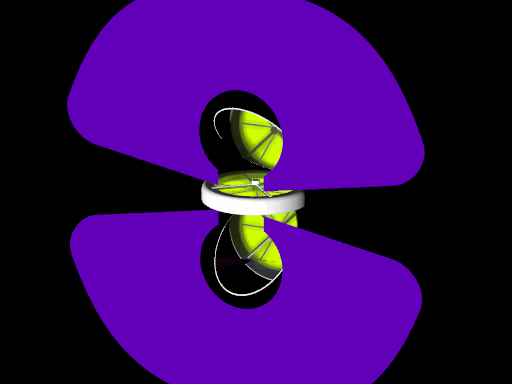Recently I read an article in the Scientific American “A Bus between the Planets” by James Oberg and Buzz Aldrin (Scientific American, 2000) proposing a habitat which loops between Earth and Mars and provides a sort of bus service between the two planets. More recently:
Aldrin Mars Cycler Buzz Aldrin – Popular Mechanics, December 2005.
This is my thoughts inspired by this idea. What follows should be regarded as science fiction.
As well as adequate shielding from radiation, humans need gravity, food and company. It seems likely that most of the time people will live in what I will call Orbiters. These I imagine will have a hollow spinning habitation wheel giving a gravity at the rim about the same as on the Earth. Surrounding this will be a non-rotating structure in which the bulk of the mass is carried. Attached to this will be solar panels to gather energy, and mirrors to direct some of the sun’s energy onto the crops growing on the two sides of the habitation wheel. This is my initial idea of the basics this might consist of rendered using PovRay:

Typically, an Orbiter will be set on a path such as that suggested by It appears that this can continue indefinitely with only a minimal need of reaction mass to keep the space ark on course. Maybe there will be another Orbiter at the Lagrange points on a line between the earth and the moon where it can sit indefinitely again with only a minimal need for reaction mass to keep it on station. With an Orbiter in orbit around Mars or even embedded in Mars’ moon, Pheobos, the trip to Mars would involve living in healthy conditions for nearly whole trip with only short transfers between Orbiters.
Life aboard an Orbiter will be busy. Always there will be crops to tend and all the other activities of normal life, but as well as this there will also be a full programme of material refining and manufacture. The basic economy of life in space will centre round making mass available and then useful. Most of this will come from asteroids, but some may come from the Moon.
There will be Orbiters that visit asteroids, which will be mined, and raw material loaded into the Orbiter. The journey back will be mainly spent refining this raw material into useful components while the journey there will be spent mostly in manufacturing.
Manufacturing will continue all the time. Parts of the Orbiter will need replacing and parts for new Orbiters and other vessels will be made. For example, in the Mars venture the habitats, landing craft, surface vehicles, orbiting facilities and stores can all be made during the journey there.
New technology will need to be developed. All the energy for manufacturing and accelerating reaction mass will come from the Sun, so large areas of more efficient solar panels will be needed. Also, thrusters need to be developed, capable of accelerating significant quantities of a variety of elements to high velocities, using power from the solar panels with high efficiency. Note that the mixture of elements mined will depend on the source and the usefulness of every element will depend on what is needed for construction and shielding. The least useful and most plentiful elements will get used as reaction mass, so the thrusters need to be versatile.
The technology of material separation and refining will be dominated by novel vacuum processes, difficult on Earth, but easy in space. Direct heating by focussed Sun’s radiation will be useful and there could be some interesting possibilities for particle separation in zero gravity.
Once established life in space has to be self-sufficient and sustainable. The cost of getting mass into space from the Earth will be far too expensive and will be a drain on Earth’s resources.
The future of humans in space will be a story about the moving of mass. The controlling factors are time, energy and delta-V (change of velocity).
Mass is needed as the raw material for making the structures to live in and reaction mass, which is thrown away: In space objects continue along the path they are on and the only way to change this path is to throw some of your mass in the right direction. The proportion of the mass you throw and the speed and therefore the energy required to throw it are a function of size of the change of path, which is measured in delta-V. Once thrown the reaction mass is lost. Mass is also needed as radiation shielding if humans are to remain healthy.
Impatience is expensive. To go on a faster path will usually mean a greater delta-V and a greater proportion of the mass that has to be thrown away. However, there are paths that minimise delta-V. Exploration in space looks like being a sort of slow and stately dance measured in years rather than days. If we are prepared to take a long time it is possible to visit many interesting places in the solar system with very little expenditure of delta-V
We can assume that this activity is confined to the solar system where the sun provides a constant source of energy
(Some time I may expand on this)
